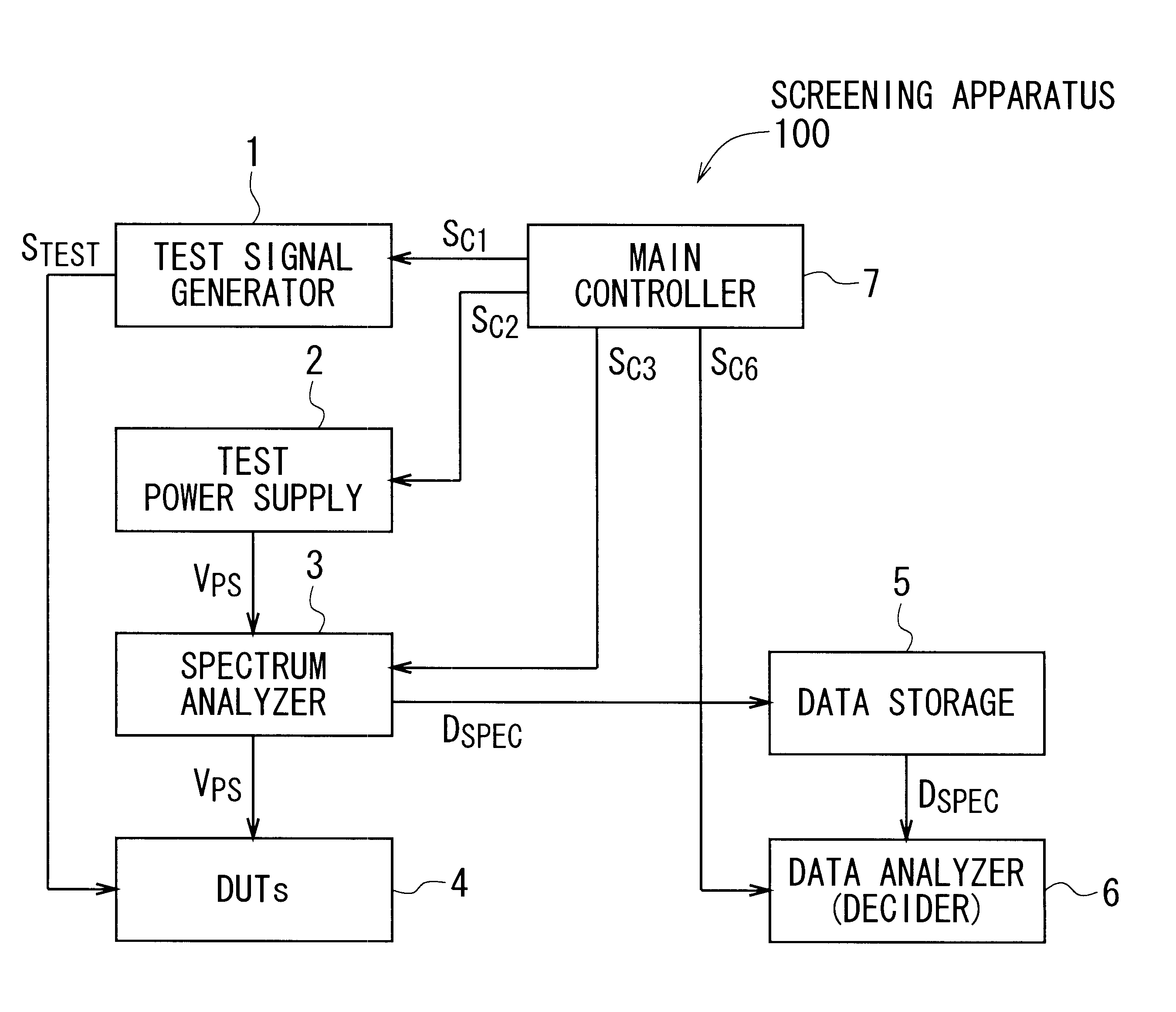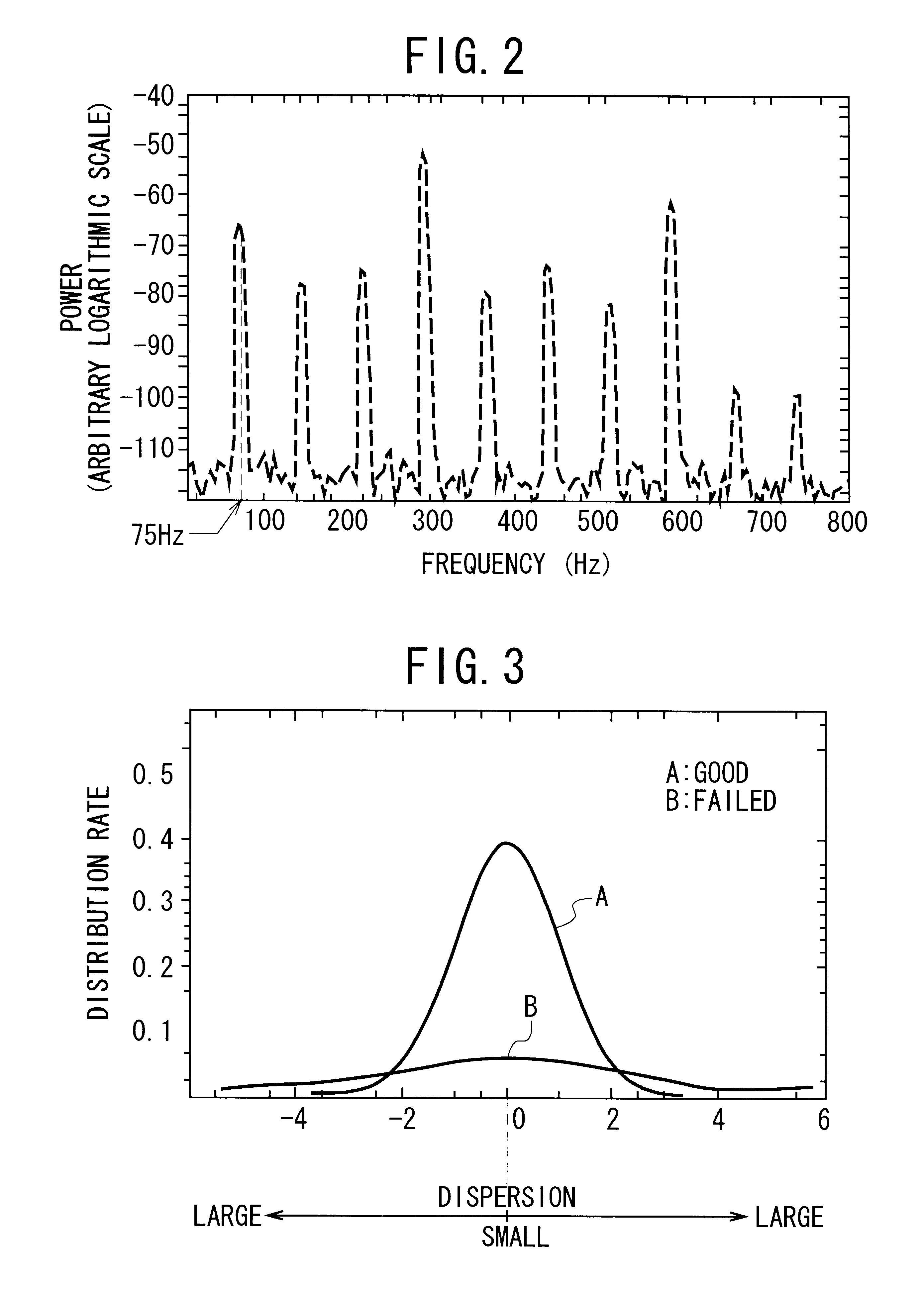Screening of semiconductor integrated circuit devices
a technology of integrated circuit devices and semiconductors, applied in the testing of individual semiconductor devices, measurement devices, instruments, etc., can solve the problems of long time, hundreds or thousands of hours to complete the test, and obvious temperature-dependent potential failures in a relatively short period of tim
- Summary
- Abstract
- Description
- Claims
- Application Information
AI Technical Summary
Benefits of technology
Problems solved by technology
Method used
Image
Examples
first embodiment
Next, prior to explanation of the screening method the principle of the method is explained below with reference to FIGS. 2 and 3.
FIG. 2 shows an example of the power spectrum of the power supply current flowing into one of the DUTs or LSIs 4, which was obtained by applying repeatedly the test signal S.sub.TEST to the respective DUTs 4 while the period T of the test signal S.sub.TEST (which includes a set of test patterns) was set as 13.3 milliseconds (ms) (i.e., T=13.3 ms). FIG. 3 shows an example of the distribution rate change as a function of dispersion of the power spectrum data D.sub.SPEC of one of the power supply currents.
The power supply current flowing into each of the DUTs 4 contains a lot of information reflecting the internal state of the DUT 4 serving as a load. In other words, if one of the DUTs 4 has a defect that leads to early failure (e.g., defective interconnections or wiring lines, defective transistors, and so on), the power supply current flows abnormally int...
second embodiment
FIG. 7 is a flowchart showing the steps of a screening method according to a second embodiment of the invention, which is carried out by the screening apparatus according to the first embodiment of FIG. 1.
As seen from FIG. 7, the method of the second embodiment comprises a step S11 of performing a burn-in test and a step S12 of performing the screening procedure (i.e., the steps S1 to S6 in FIG. 4). In other words, the method of the second embodiment is the combination of a burn-in test and the steps S1 to S6 in the screening method according to the first embodiment.
Thus, with the screening method of the second embodiment, a burn-in test is carried out in a short period of time before the screening procedure (i.e., S1 to S6) and therefore, the potential faulty existing in the DUTs 4 tend to be elicited prior to the procedure As a result, there is an additional advantage that the faulty LSIs or DUTs 4 with potential failure therein can be screened out at a higher accuracy than the me...
third embodiment
FIG. 8 is a flowchart showing the steps of a screening method according to a third embodiment of the invention, which is carried out by the screening apparatus according to the first embodiment of FIG. 1.
As seen from FIG. 8, the method of the third embodiment comprises a step S21 of performing the screening procedure (i.e., the steps S1 to 96 in FIG. 4), a step S22 of performing the screening procedure (i.e., the steps S1 to S6 in FIG. 4) during a burn-in test, and a step S23 of performing the screening procedure (i.e., the steps S1 to S6 in FIG. 4). In other words, the steps S1 to S6 in the screening method according to the first embodiment are carried out (the first time) in the step S21 before a burn-in test is started, the same steps S1 to S6 are carried out (the second time) during the burn-in test in the step S22, and the same steps S1 to S6 are carried out (the third time) in the step S23 after the burn-in test is completed.
Specifically, with the screening method of the third...
PUM
 Login to View More
Login to View More Abstract
Description
Claims
Application Information
 Login to View More
Login to View More - R&D
- Intellectual Property
- Life Sciences
- Materials
- Tech Scout
- Unparalleled Data Quality
- Higher Quality Content
- 60% Fewer Hallucinations
Browse by: Latest US Patents, China's latest patents, Technical Efficacy Thesaurus, Application Domain, Technology Topic, Popular Technical Reports.
© 2025 PatSnap. All rights reserved.Legal|Privacy policy|Modern Slavery Act Transparency Statement|Sitemap|About US| Contact US: help@patsnap.com



